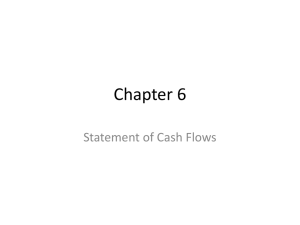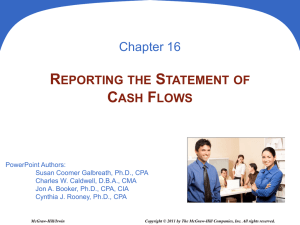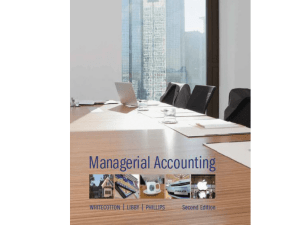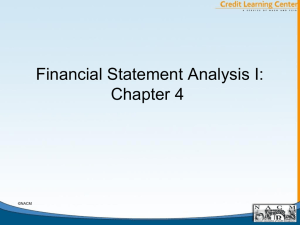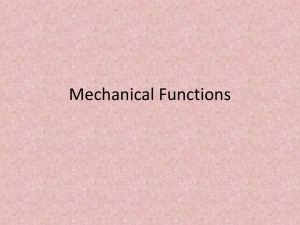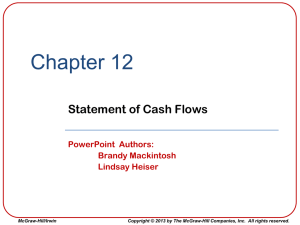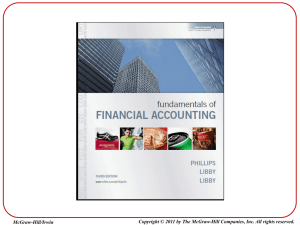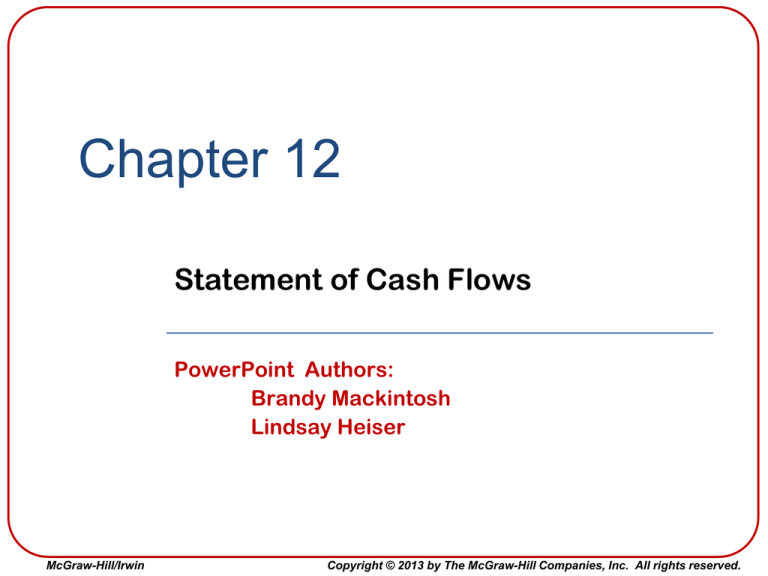
Chapter 12
Statement of Cash Flows
PowerPoint Authors:
Brandy Mackintosh
Lindsay Heiser
McGraw-Hill/Irwin
Copyright © 2013 by The McGraw-Hill Companies, Inc. All rights reserved.
Learning Objective 12-1
Identify cash flows arising
from operating, investing,
and financing activities.
12-2
Business Activities and Cash Flows
The Statement of
Cash Flows focuses
attention on:
Operations
Cash received and paid
for day-to-day activities
with customers, suppliers,
and employees.
Investing
Cash paid and received
from buying and selling
long-term assets.
12-3
Financing
Cash received and paid
for exchanges with
lenders and stockholders.
Business Activities and Cash Flows
Checking and
Savings
Accounts
Cash
Currency
Cash Equivalents
Highly liquid short-term investments
within three months of maturity.
12-4
Classifying Cash Flows
UNDER ARMOUR, INC.
Statement of Cash Flows
For the Year Ended December 31, 2010
(in millions)
Net cash provided (used) by operating activities
37
Net cash provided (used) by investing activities
(41)
Net cash provided (used) by financing activities
7
Net Change in Cash and Cash Equivalents
3
Cash and cash equivalents, beginning of year
Cash and cash equivalents, end of year
12-5
$
187
$ 190
Operating Activities
Cash inflows and outflows that directly relate
to revenues and expenses reported on the
Income Statement.
12-6
Investing Activities
Under Armour’s 2010 Investing Activities
12-7
Financing Activities
Under Armour’s 2010 Financing Activities
12-8
Relationships Between Classified
Balance Sheet and Statement of Cash
Flow (SCF) Categories
12-9
Relationship to Other Financial
Statements
Information needed to prepare a Statement of
Cash Flows:
Comparative Balance Sheets.
Income Statement.
Additional details concerning
selected accounts.
12-10
Relationship to Other Financial
Statements
Recall that the basic Balance Sheet equation is:
We can recast the equation as follows:
The following equation is true:
From this basic Balance Sheet equation, we
develop our model to solve for the change in cash:
12-11
Direct and Indirect Reporting
of Operating Cash Flows
Same result
We will concentrate on the indirect method for now, and we
will look at the direct method again later in the chapter.
12-12
Learning Objective 12-2
Report cash flows from
operating activities, using
the indirect method.
12-13
Cash Flows from Operating
Activities - Indirect Method
The indirect method adjusts Net Income
by analyzing noncash items.
Changes in Current Assets
and Current Liabilities.
Cash Flows
from Operating
Activities Indirect Method
Net
Income
+ Noncash
expenses such as
Depreciation and
Amortization.
12-14
+ Losses and
- Gains
Relationships to the Balance
Sheet and the Income Statement
Change in account
balances during the year
Increase
Decrease
Current Assets
Subtract from
net income.
Add to
net income.
Current Liabilities
Add to
net income.
Subtract from
net income.
Use this table when adjusting Net Income to operating
cash flows using the indirect method.
12-15
Statement of Cash Flows
Indirect Method Example
Use the following
financial statements
for Under Armour,
Inc. and prepare the
Statement of Cash
Flows for the year
ended December 31,
2010.
12-16
Statement of Cash Flows
Indirect Method Example
12-17
Statement of Cash Flows
Indirect Method Example
12-18
Statement of Cash Flows
Indirect Method Example
The Statement
of Cash Flows
using the
indirect
method will
begin with
Under Armor,
Inc.’s Net
Income from
the Income
Statement.
12-19
Direct and Indirect Reporting
of Operating Cash Flows
When using the indirect method, start with accrual basis
Net Income and adjust it for:
1. items that are included in Net Income but do not
involve cash, and
2. items that are not included in Net Income but do
involve cash.
12-20
Next, adjust for the non-cash items included
in Net Income.
For Under Armour, the only non-cash adjustment
is for Depreciation Expense.
12-21
Accumulated Depreciation increased by $17, from $70 in the 2009
Balance Sheet to $87 in the 2010 Balance sheet. The same $17 is
shown as Depreciation Expense in the 2010 Income Statement.
To complete the Cash Flows from Operating Activities section, we
must examine comparative Balance Sheets to determine the
changes in current assets and current liabilities from the beginning
of the period to the end of the period.
12-22
These five items were shown earlier in the current portions of
Under Armour’s comparative Balance Sheets for 2009 and 2010
Increase
Decrease
12-23
Current Assets
Subtract from
net income.
Add to
net income.
Current Liabilities
Add to
net income.
Subtract from
net income.
Learning Objective 12-3
Report cash flows from
investing activities.
12-24
Reporting Cash Flows from
Investing Activities
We will need this additional data to prepare
the investing portion of the statement.
1. No disposals or impairments of Equipment or
Intangibles occurred
2. Equipment costing $30 million and Intangibles
costing $11 million were purchased with Cash.
12-25
Reporting Cash Flows from
Investing Activities
Under Armour, Inc., has two investing
activities on the Statement of Cash Flows that
required the use of Cash:
1. Purchase of Equipment, and
2. Purchase of Intangibles and Other Assets.
12-26
Learning Objective 12-4
Report cash flows from
financing activities.
12-27
Reporting Cash Flows from
Financing Activities
We will need this additional data to prepare
the financing portion of the statement.
1. No Dividends were declared or paid.
2. Long-term Debt of $5 million was paid.
3. $9 million in new long-term loans were issued.
4. Shares of Stock were issued for $3 million.
12-28
Reporting Cash Flows from
Financing Activities
Long-term Debt increased because of $9 in
new loans during the year. The long-term Debt
increase is a Cash inflow.
12-29
Reporting Cash Flows from
Financing Activities
Payments on Long-term Debt resulted in a Cash outflow
of $5. The net effect of these two Long-term Debt
transactions increased Long-term Debt by $4, from $25 on
the 2009 Balance Sheet to $29 on the 2010 Balance Sheet.
12-30
Reporting Cash Flows from
Financing Activities
The third financing activity is the issuance of Common Stock
resulting in a Cash inflow of $3. Contributed Capital increased from
$224 in the 2009 Balance Sheet to $227 in the 2010 Balance Sheet.
12-31
Reporting Cash Flows from
Financing Activities
Now we can reconcile the change in Cash to the ending
$190 Cash balance that appears on the Balance Sheet.
12-32
Noncash Investing and
Financing Activities
Required Supplemental Information:
1. Cash paid for taxes and interest.
2. Significant non-cash investing and
financing activities.
12-33
Learning Objective 12-5
Interpret cash flows from
operating, investing, and
financing activities.
12-34
Evaluating Operating Cash Flows
• Operating cash flows must
be positive over the longrun for a company to be
successful.
• An upward trend in
operating cash flows over
time indicates growth and
efficient operations.
• Look at the relationship
between operating cash
flows and Net Income.
12-35
Evaluating Investing Cash Flows
• Healthy companies tend to
show negative cash flows
in the investing activities
section.
• Be cautious over a positive
total cash flow in the
investing activities section
12-36
Evaluating Financing Cash Flows
• It’s not possible to evaluate
the company’s financing
cash flows by simply
determining whether they
are positive or negative on
an overall basis.
• Instead, consider detailed
line items with this section
to assess the company’s
overall financing strategy.
12-37
Overall Patterns of Cash Flows
12-38
Learning Objective 12-6
Report and interpret cash
flows from operating activities
using the direct method.
12-39
Reporting Operating Cash Flows
with the Direct Method
12-40
Provides more
detailed information
Identifies cash
inflows and
outflows
relationships
Prepared by
adjusting accrual
basis to cash basis
Investing and
financing sections
for the two methods
are identical
Direct Method Operating Activities
When we prepared the operating section using the indirect
method, we also arrived at net cash inflow of $37.
Let’s see how we arrive at these cash flows.
12-41
Direct Method Operating Activities
With the direct method, we convert each revenue and
expense on the Income Statement to a cash flow.
12-42
Supplement 12A
Reporting Disposals of Property,
Plant, and Equipment (Indirect
Method)
McGraw-Hill/Irwin
Copyright © 2013 by The McGraw-Hill Companies, Inc. All rights reserved.
Reporting Sales of Property, Plant,
and Equipment (PPE) (Indirect)
Depreciation
Expense
Loss on Sale
of PPE
Gain on Sale
of PPE
12-44
A loss on the sale of PPE is added
back to Net Income just as
Depreciation Expense is added back.
Adding these noncash items restores
Net Income to what it would have
been had Depreciation and the loss
not been subtracted at all.
Just the opposite is true for a gain on
the sale of PPE. Subtracting the gain
reverses the effect of the gain having
been added to Net Income.
Supplement 12B
T-Account (Indirect Method)
McGraw-Hill/Irwin
Copyright © 2013 by The McGraw-Hill Companies, Inc. All rights reserved.
T-account Approach
(Indirect Method)
Instead of creating schedules for each section of the
Statement of Cash Flows, some prefer to prepare a
single large T-account to represent the changes that
have taken place in Cash subdivided into the three
sections of the Statement of Cash Flows.
Let’s see how to use a T-account to prepare a
Statement of Cash Flows on the next slide.
12-46
T-account Approach(Indirect Method)
12-47
Supplement 12C
Spreadsheet Approach (Indirect
Method)
McGraw-Hill/Irwin
Copyright © 2013 by The McGraw-Hill Companies, Inc. All rights reserved.
Spreadsheet Approach
(Indirect Method)
Reconstructing the events and transactions that
occurred during the period helps identify the
operating, investing and financing activities to be
reported.
A spreadsheet can be used to ensure that
no reportable activities are inadvertently
overlooked.
Let’s see how to use a spreadsheet to prepare a
Statement of Cash Flows on the next few slides.
12-49
We begin by entering the
beginning and ending
balances for each account
on the comparative Balance
Sheets.
12-50
The cash inflows and
outflows columns will be
used later to explain the
changes in each account
balance.
Changes in
Balance Sheet
accounts are
analyzed in terms
of debits and
credits in the top
half of the
spreadsheet and
recorded as cash
inflows and
outflows in the
bottom half of the
spreadsheet.
We will begin with
operating activities.
12-51
Changes in
Balance Sheet
accounts are
analyzed in
terms of debits
and credits in
the top half of
the spreadsheet
and recorded as
cash inflows and
outflows in the
bottom half of
the spreadsheet.
Now we will
complete the
analysis with
investing and
financing
activities.
12-52
Spreadsheet Approach(Indirect Method)
The top of the completed
spreadsheet
is shown here.
12-53
Spreadsheet Approach(Indirect Method)
The bottom of
the completed
spreadsheet
is shown here.
12-54
End of Chapter 12
12-55

